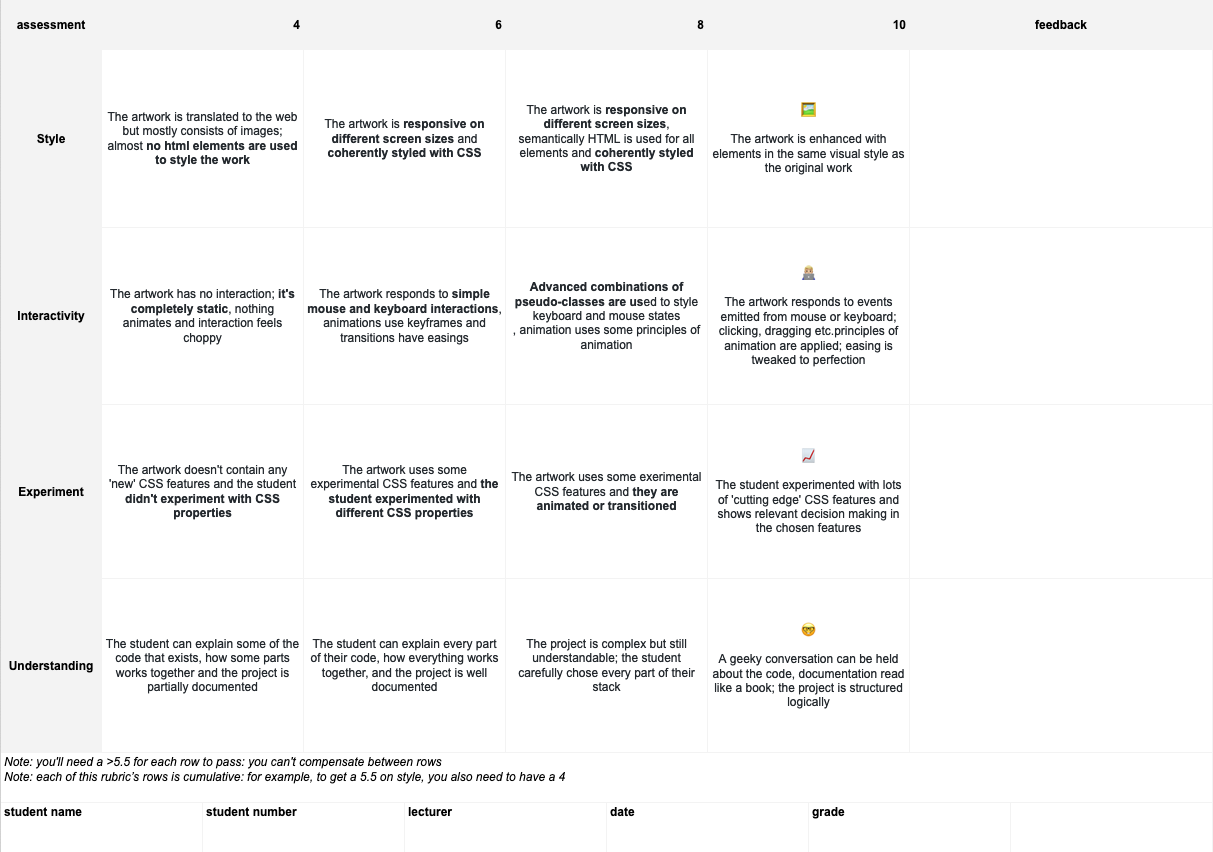web-animation-19-20
Table of Contents
Test
You’ve worked iteratively (formative) on your product and finish with an oral test (summative) where you present your final project. You will show you can create a quality project in which you apply the subject matter of this course and that you understand it. You will answer questions in such a way as to demonstrate sufficient knowledge of our goals. This is an individual project so oral tests will be conducted 1 on 1.
Check rooster.hva.nl or Brightspace schedulers for info on actual date, time, and place.
Preparation
Presenting your work is a skill all by itself, make sure you prepare yourself properly. The best way is to treat it as public speaking and there are many books on public speaking available.
- Have the latest version of your code ready in your editor.
- Open up your docs inside of your GitHub repository.
- Have a live version up and running.
- Feedback will be giving during the test, make sure you have something to take notes with.
Make sure your repository stays online after the oral test is finished, we might want to check the code handed in on GitHub after the test. We also want to download and archive your project when it’s done.
Rubric
| Checklist |
|---|
| Source code is available on GitHub |
| Live version of the application is deployed (gh pages) |
Project is documented and has a readme.md |
| Cites the sources used; either in code comments or APA style in readme |

View the Rubric in Google drive →
Note: you’ll need a > 5.5 for each row to pass: you can’t compensate between rows each of this rubric’s rows is cumulative: for example, to get a 6 on style, you also need to have a 4.
Grade
| Task | Weight |
|---|---|
| Prototype (oral test) | 100% |
| Total | 100% |
Publishing
Grades will be published and communicated trough Brightspace and Slack based on student numbers.
- Final grades will be published one week after test date.
- Final grades will be put in SIS two weeks after test date.
After the oral test you can request viewing time for additional feedback, this can be useful for a resit. Feel free to contact your lecturer if you want to do so.
Plagiarism
💁 We don’t like plagiarism and report it to our assessment committee (examencommissie in Dutch). See ¶ 6.1.2 of Teaching and Examination Regulations (TER) 2017-2018 (in Dutch: Onderwijs- en examenregeling, OER) for a full definition, but here are a few cases that count as plagiarism:
a. using or copying someone else’s texts, data or ideas without a full and correct acknowledgement of sources; b. presenting the structure or central ideas developed by someone else as your own work or ideas, even when a reference to other authors has been included;
[…]
e. copying (parts of) media files or other sources, software source codes, models and other diagrams of other people without acknowledgement and allowing it to be held as your own work;
[…]
g. copying the work of fellow-students and allowing it to be held as your own work;
[…]
You are not allowed to simply use portions of someone else’s work in your project. The copyright is owned by the creator of the work. You must cite the sources used. Quoting or using material without a source citation is plagiarism and is punishable.
More information on the Student Copyright Information Point
The manner in which you cite your sources depends. The most widely used style at the AUAS is APA of the American Psychological Association. Make sure you cite your sources in the repository or documentation of your project on GitHub.